Human Resource Development Report: Productivity and Competitiveness
VerifiedAdded on 2021/05/30
|7
|1721
|45
Report
AI Summary
This report provides a comprehensive analysis of Human Resource Development (HRD) in Australia, focusing on its crucial role in enhancing productivity and economic growth. It explores the relationship between human capital formation, business competitiveness, and the effectiveness of Vocational Education and Training (VET) systems. The report examines the challenges faced by employers in securing skilled staff, the limitations of current VET systems, and the importance of public-private partnerships. It also investigates the impact of HRD on microeconomic levels, including wages and business innovation. The report emphasizes the need for data-driven HR practices and the development of digital competencies. Finally, it highlights the significance of employability skills, the evolution of work structures, and the development of new positions in response to technological advances and the demands of the modern workplace. The report concludes by emphasizing the importance of aligning educational and labor policies to foster economic growth and business success.

1
Human Resource Development
Name:
Course
Professor’s name
University name
City, State
Date of submission
Human Resource Development
Name:
Course
Professor’s name
University name
City, State
Date of submission
Paraphrase This Document
Need a fresh take? Get an instant paraphrase of this document with our AI Paraphraser
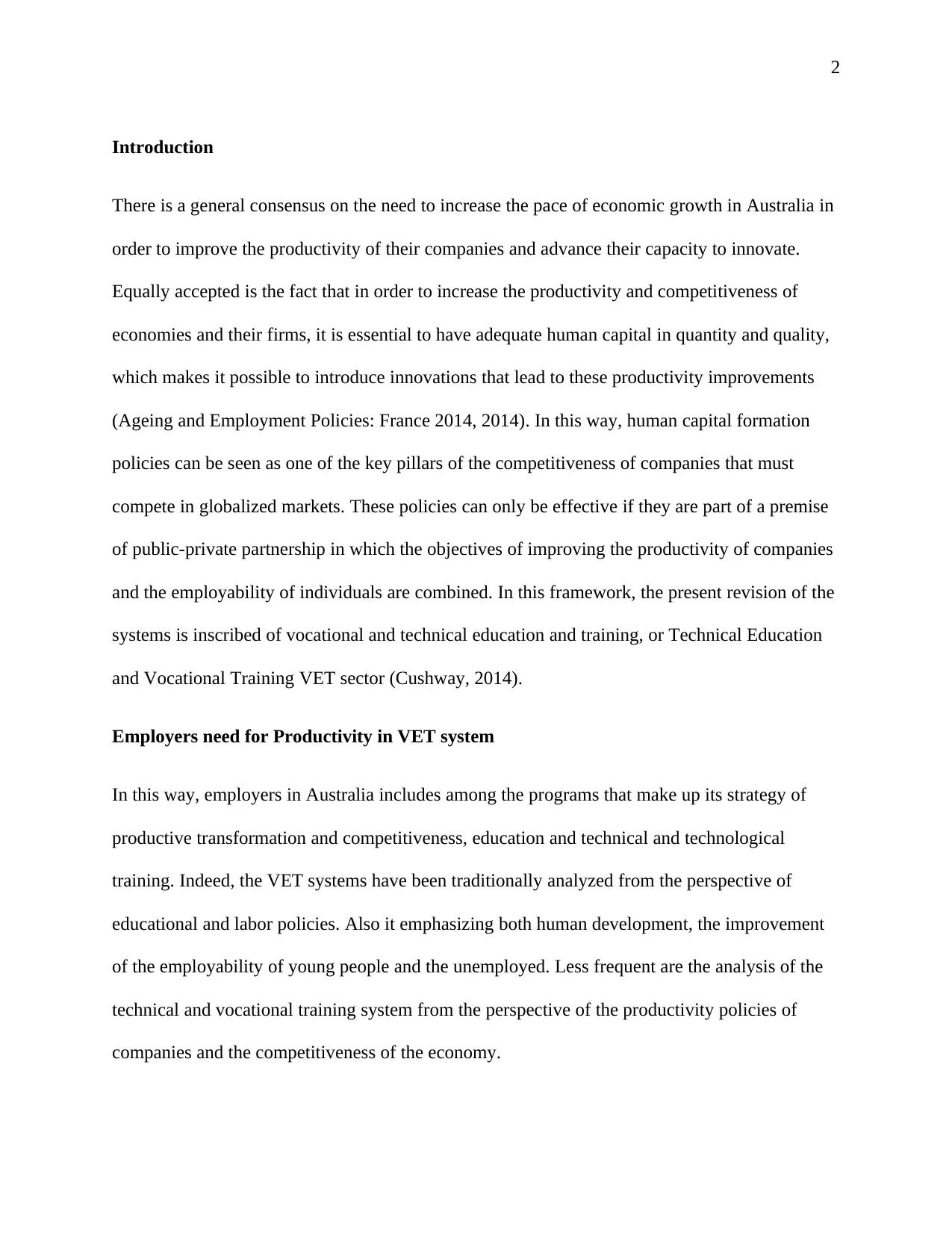
2
Introduction
There is a general consensus on the need to increase the pace of economic growth in Australia in
order to improve the productivity of their companies and advance their capacity to innovate.
Equally accepted is the fact that in order to increase the productivity and competitiveness of
economies and their firms, it is essential to have adequate human capital in quantity and quality,
which makes it possible to introduce innovations that lead to these productivity improvements
(Ageing and Employment Policies: France 2014, 2014). In this way, human capital formation
policies can be seen as one of the key pillars of the competitiveness of companies that must
compete in globalized markets. These policies can only be effective if they are part of a premise
of public-private partnership in which the objectives of improving the productivity of companies
and the employability of individuals are combined. In this framework, the present revision of the
systems is inscribed of vocational and technical education and training, or Technical Education
and Vocational Training VET sector (Cushway, 2014).
Employers need for Productivity in VET system
In this way, employers in Australia includes among the programs that make up its strategy of
productive transformation and competitiveness, education and technical and technological
training. Indeed, the VET systems have been traditionally analyzed from the perspective of
educational and labor policies. Also it emphasizing both human development, the improvement
of the employability of young people and the unemployed. Less frequent are the analysis of the
technical and vocational training system from the perspective of the productivity policies of
companies and the competitiveness of the economy.
Introduction
There is a general consensus on the need to increase the pace of economic growth in Australia in
order to improve the productivity of their companies and advance their capacity to innovate.
Equally accepted is the fact that in order to increase the productivity and competitiveness of
economies and their firms, it is essential to have adequate human capital in quantity and quality,
which makes it possible to introduce innovations that lead to these productivity improvements
(Ageing and Employment Policies: France 2014, 2014). In this way, human capital formation
policies can be seen as one of the key pillars of the competitiveness of companies that must
compete in globalized markets. These policies can only be effective if they are part of a premise
of public-private partnership in which the objectives of improving the productivity of companies
and the employability of individuals are combined. In this framework, the present revision of the
systems is inscribed of vocational and technical education and training, or Technical Education
and Vocational Training VET sector (Cushway, 2014).
Employers need for Productivity in VET system
In this way, employers in Australia includes among the programs that make up its strategy of
productive transformation and competitiveness, education and technical and technological
training. Indeed, the VET systems have been traditionally analyzed from the perspective of
educational and labor policies. Also it emphasizing both human development, the improvement
of the employability of young people and the unemployed. Less frequent are the analysis of the
technical and vocational training system from the perspective of the productivity policies of
companies and the competitiveness of the economy.
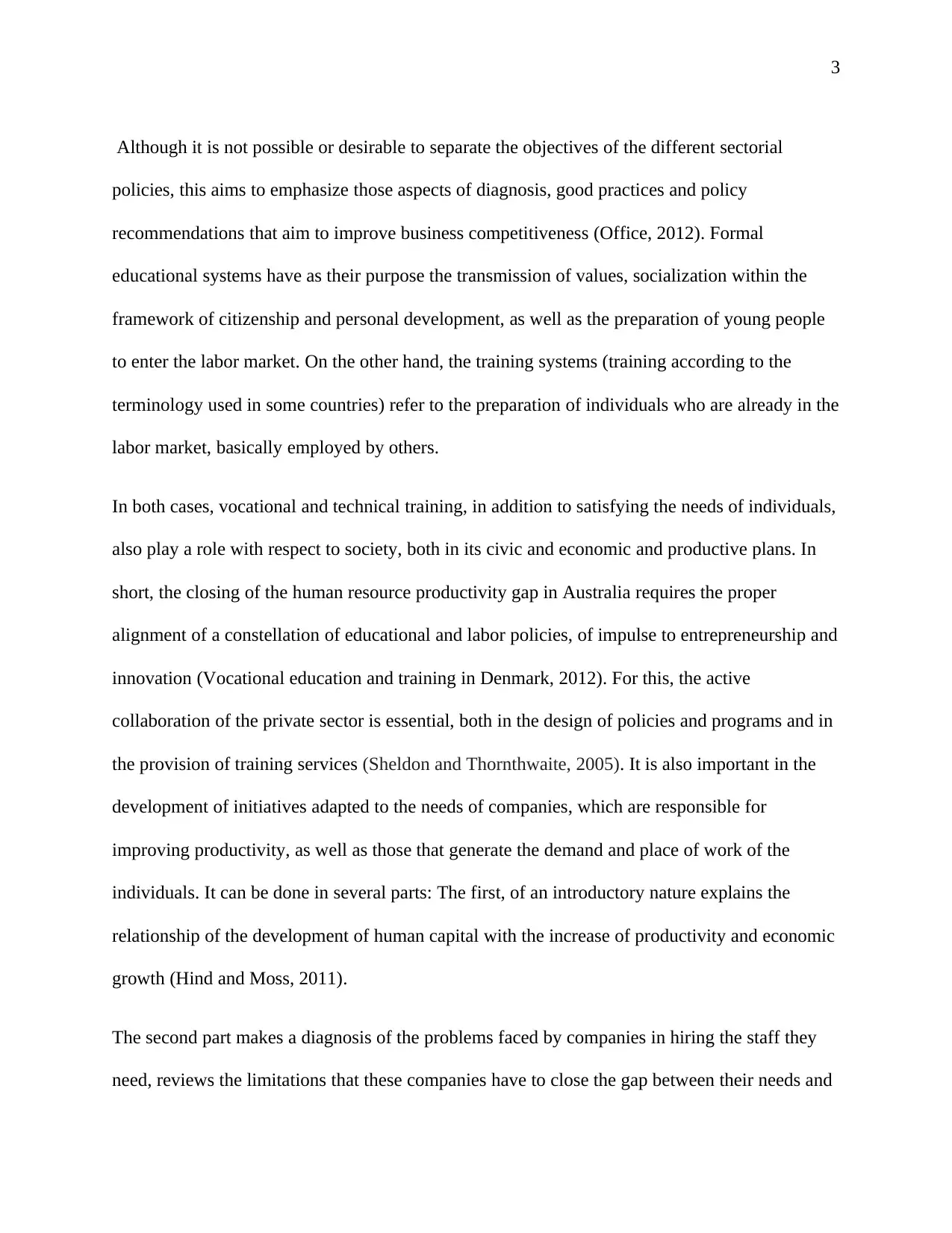
3
Although it is not possible or desirable to separate the objectives of the different sectorial
policies, this aims to emphasize those aspects of diagnosis, good practices and policy
recommendations that aim to improve business competitiveness (Office, 2012). Formal
educational systems have as their purpose the transmission of values, socialization within the
framework of citizenship and personal development, as well as the preparation of young people
to enter the labor market. On the other hand, the training systems (training according to the
terminology used in some countries) refer to the preparation of individuals who are already in the
labor market, basically employed by others.
In both cases, vocational and technical training, in addition to satisfying the needs of individuals,
also play a role with respect to society, both in its civic and economic and productive plans. In
short, the closing of the human resource productivity gap in Australia requires the proper
alignment of a constellation of educational and labor policies, of impulse to entrepreneurship and
innovation (Vocational education and training in Denmark, 2012). For this, the active
collaboration of the private sector is essential, both in the design of policies and programs and in
the provision of training services (Sheldon and Thornthwaite, 2005). It is also important in the
development of initiatives adapted to the needs of companies, which are responsible for
improving productivity, as well as those that generate the demand and place of work of the
individuals. It can be done in several parts: The first, of an introductory nature explains the
relationship of the development of human capital with the increase of productivity and economic
growth (Hind and Moss, 2011).
The second part makes a diagnosis of the problems faced by companies in hiring the staff they
need, reviews the limitations that these companies have to close the gap between their needs and
Although it is not possible or desirable to separate the objectives of the different sectorial
policies, this aims to emphasize those aspects of diagnosis, good practices and policy
recommendations that aim to improve business competitiveness (Office, 2012). Formal
educational systems have as their purpose the transmission of values, socialization within the
framework of citizenship and personal development, as well as the preparation of young people
to enter the labor market. On the other hand, the training systems (training according to the
terminology used in some countries) refer to the preparation of individuals who are already in the
labor market, basically employed by others.
In both cases, vocational and technical training, in addition to satisfying the needs of individuals,
also play a role with respect to society, both in its civic and economic and productive plans. In
short, the closing of the human resource productivity gap in Australia requires the proper
alignment of a constellation of educational and labor policies, of impulse to entrepreneurship and
innovation (Vocational education and training in Denmark, 2012). For this, the active
collaboration of the private sector is essential, both in the design of policies and programs and in
the provision of training services (Sheldon and Thornthwaite, 2005). It is also important in the
development of initiatives adapted to the needs of companies, which are responsible for
improving productivity, as well as those that generate the demand and place of work of the
individuals. It can be done in several parts: The first, of an introductory nature explains the
relationship of the development of human capital with the increase of productivity and economic
growth (Hind and Moss, 2011).
The second part makes a diagnosis of the problems faced by companies in hiring the staff they
need, reviews the limitations that these companies have to close the gap between their needs and
⊘ This is a preview!⊘
Do you want full access?
Subscribe today to unlock all pages.

Trusted by 1+ million students worldwide
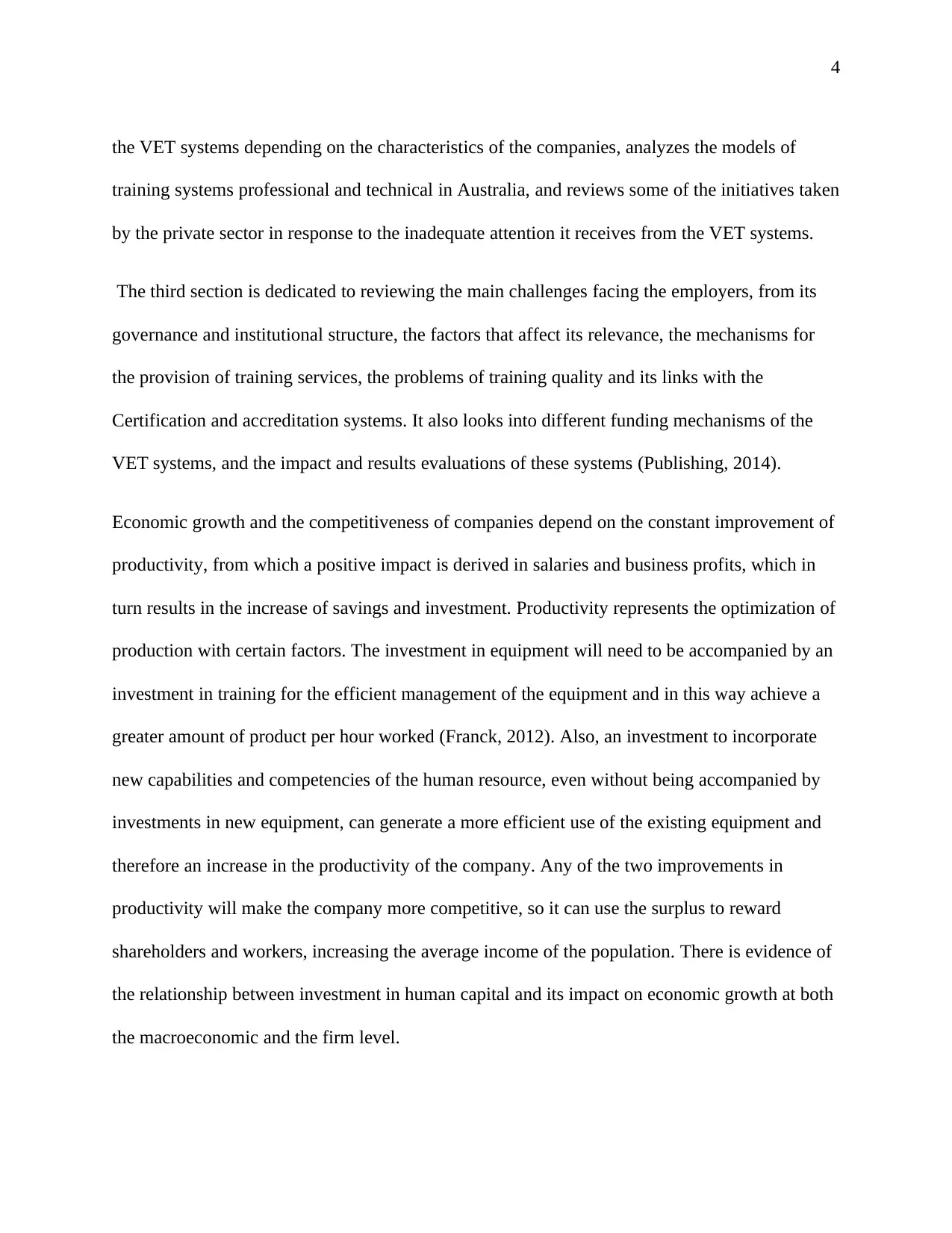
4
the VET systems depending on the characteristics of the companies, analyzes the models of
training systems professional and technical in Australia, and reviews some of the initiatives taken
by the private sector in response to the inadequate attention it receives from the VET systems.
The third section is dedicated to reviewing the main challenges facing the employers, from its
governance and institutional structure, the factors that affect its relevance, the mechanisms for
the provision of training services, the problems of training quality and its links with the
Certification and accreditation systems. It also looks into different funding mechanisms of the
VET systems, and the impact and results evaluations of these systems (Publishing, 2014).
Economic growth and the competitiveness of companies depend on the constant improvement of
productivity, from which a positive impact is derived in salaries and business profits, which in
turn results in the increase of savings and investment. Productivity represents the optimization of
production with certain factors. The investment in equipment will need to be accompanied by an
investment in training for the efficient management of the equipment and in this way achieve a
greater amount of product per hour worked (Franck, 2012). Also, an investment to incorporate
new capabilities and competencies of the human resource, even without being accompanied by
investments in new equipment, can generate a more efficient use of the existing equipment and
therefore an increase in the productivity of the company. Any of the two improvements in
productivity will make the company more competitive, so it can use the surplus to reward
shareholders and workers, increasing the average income of the population. There is evidence of
the relationship between investment in human capital and its impact on economic growth at both
the macroeconomic and the firm level.
the VET systems depending on the characteristics of the companies, analyzes the models of
training systems professional and technical in Australia, and reviews some of the initiatives taken
by the private sector in response to the inadequate attention it receives from the VET systems.
The third section is dedicated to reviewing the main challenges facing the employers, from its
governance and institutional structure, the factors that affect its relevance, the mechanisms for
the provision of training services, the problems of training quality and its links with the
Certification and accreditation systems. It also looks into different funding mechanisms of the
VET systems, and the impact and results evaluations of these systems (Publishing, 2014).
Economic growth and the competitiveness of companies depend on the constant improvement of
productivity, from which a positive impact is derived in salaries and business profits, which in
turn results in the increase of savings and investment. Productivity represents the optimization of
production with certain factors. The investment in equipment will need to be accompanied by an
investment in training for the efficient management of the equipment and in this way achieve a
greater amount of product per hour worked (Franck, 2012). Also, an investment to incorporate
new capabilities and competencies of the human resource, even without being accompanied by
investments in new equipment, can generate a more efficient use of the existing equipment and
therefore an increase in the productivity of the company. Any of the two improvements in
productivity will make the company more competitive, so it can use the surplus to reward
shareholders and workers, increasing the average income of the population. There is evidence of
the relationship between investment in human capital and its impact on economic growth at both
the macroeconomic and the firm level.
Paraphrase This Document
Need a fresh take? Get an instant paraphrase of this document with our AI Paraphraser
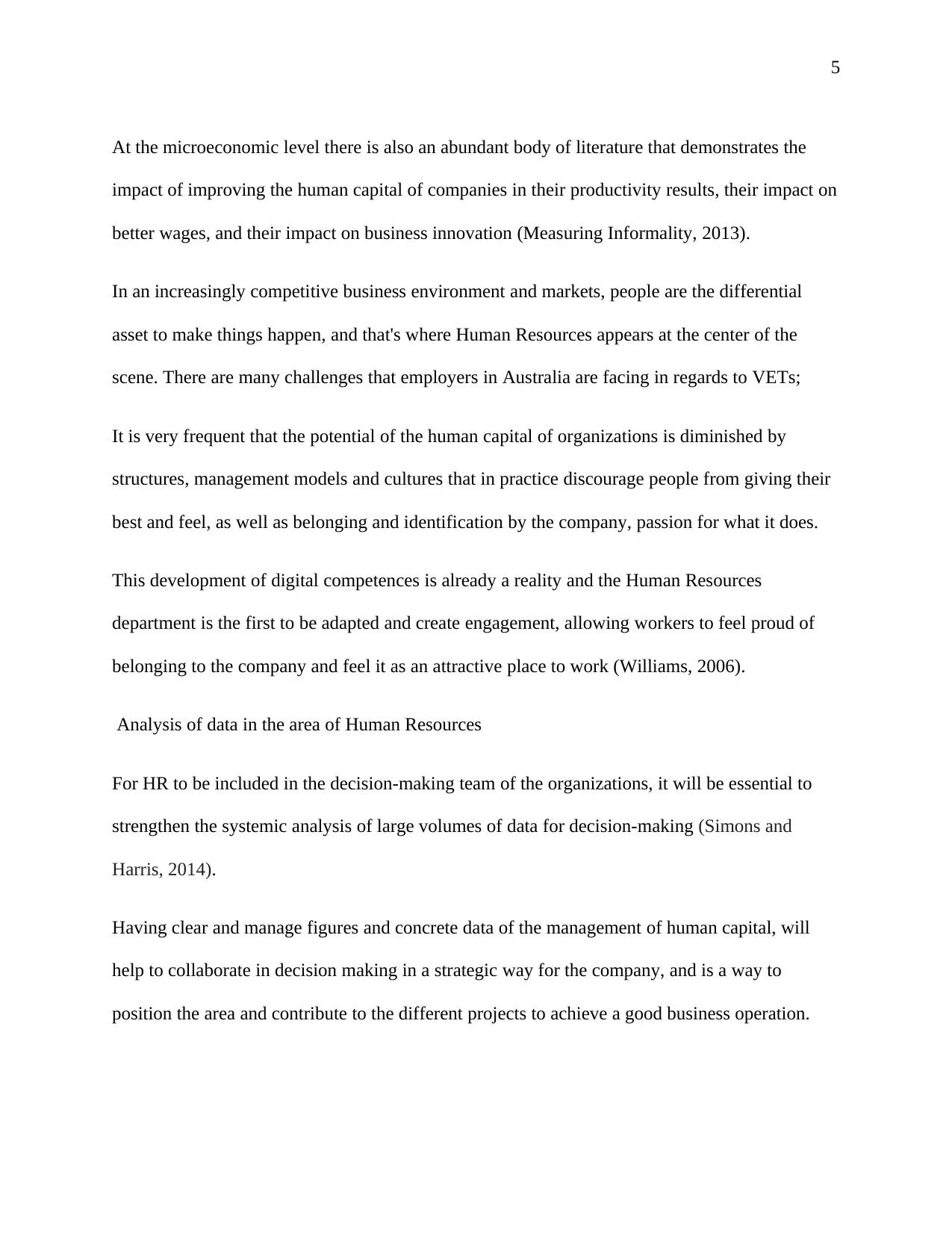
5
At the microeconomic level there is also an abundant body of literature that demonstrates the
impact of improving the human capital of companies in their productivity results, their impact on
better wages, and their impact on business innovation (Measuring Informality, 2013).
In an increasingly competitive business environment and markets, people are the differential
asset to make things happen, and that's where Human Resources appears at the center of the
scene. There are many challenges that employers in Australia are facing in regards to VETs;
It is very frequent that the potential of the human capital of organizations is diminished by
structures, management models and cultures that in practice discourage people from giving their
best and feel, as well as belonging and identification by the company, passion for what it does.
This development of digital competences is already a reality and the Human Resources
department is the first to be adapted and create engagement, allowing workers to feel proud of
belonging to the company and feel it as an attractive place to work (Williams, 2006).
Analysis of data in the area of Human Resources
For HR to be included in the decision-making team of the organizations, it will be essential to
strengthen the systemic analysis of large volumes of data for decision-making (Simons and
Harris, 2014).
Having clear and manage figures and concrete data of the management of human capital, will
help to collaborate in decision making in a strategic way for the company, and is a way to
position the area and contribute to the different projects to achieve a good business operation.
At the microeconomic level there is also an abundant body of literature that demonstrates the
impact of improving the human capital of companies in their productivity results, their impact on
better wages, and their impact on business innovation (Measuring Informality, 2013).
In an increasingly competitive business environment and markets, people are the differential
asset to make things happen, and that's where Human Resources appears at the center of the
scene. There are many challenges that employers in Australia are facing in regards to VETs;
It is very frequent that the potential of the human capital of organizations is diminished by
structures, management models and cultures that in practice discourage people from giving their
best and feel, as well as belonging and identification by the company, passion for what it does.
This development of digital competences is already a reality and the Human Resources
department is the first to be adapted and create engagement, allowing workers to feel proud of
belonging to the company and feel it as an attractive place to work (Williams, 2006).
Analysis of data in the area of Human Resources
For HR to be included in the decision-making team of the organizations, it will be essential to
strengthen the systemic analysis of large volumes of data for decision-making (Simons and
Harris, 2014).
Having clear and manage figures and concrete data of the management of human capital, will
help to collaborate in decision making in a strategic way for the company, and is a way to
position the area and contribute to the different projects to achieve a good business operation.
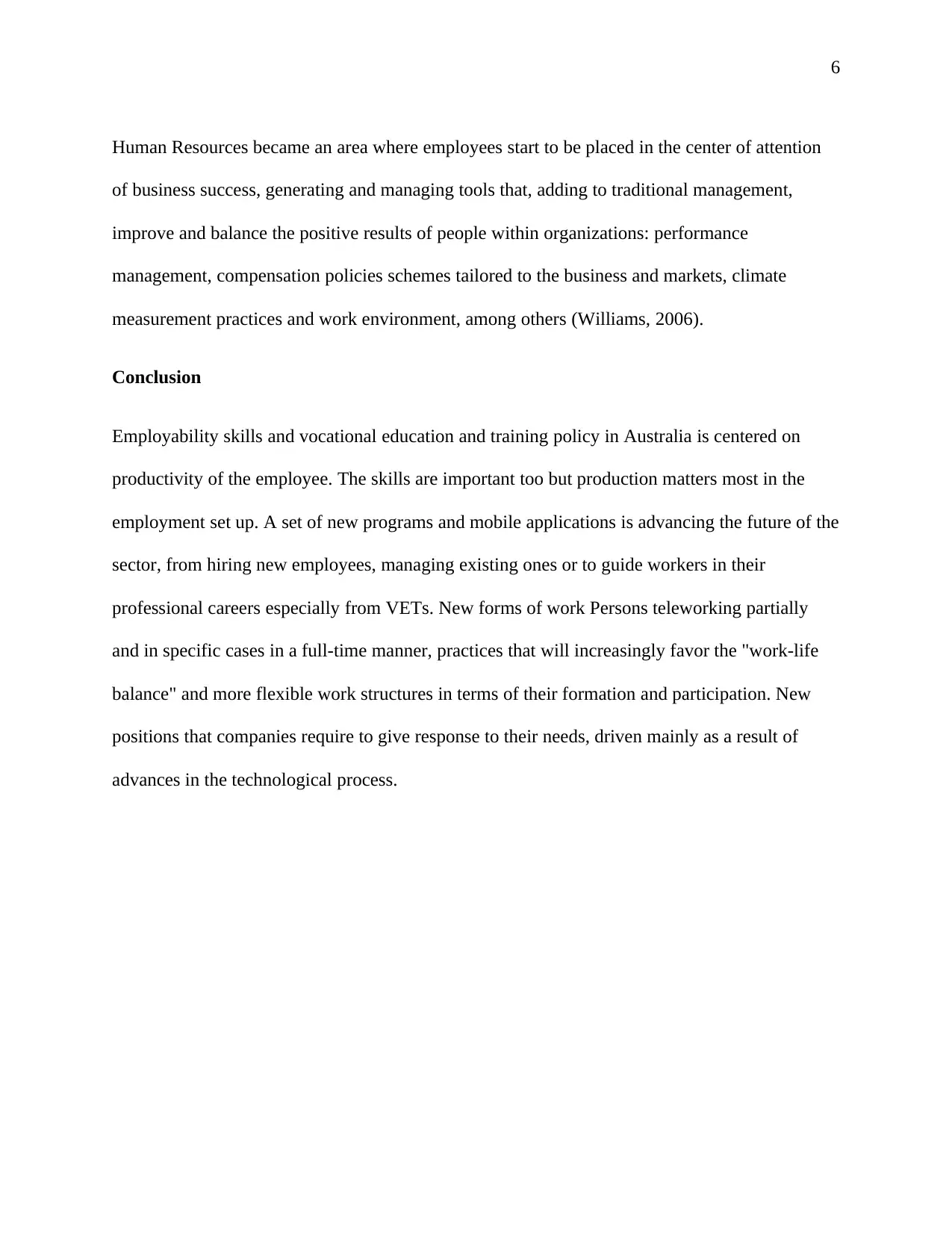
6
Human Resources became an area where employees start to be placed in the center of attention
of business success, generating and managing tools that, adding to traditional management,
improve and balance the positive results of people within organizations: performance
management, compensation policies schemes tailored to the business and markets, climate
measurement practices and work environment, among others (Williams, 2006).
Conclusion
Employability skills and vocational education and training policy in Australia is centered on
productivity of the employee. The skills are important too but production matters most in the
employment set up. A set of new programs and mobile applications is advancing the future of the
sector, from hiring new employees, managing existing ones or to guide workers in their
professional careers especially from VETs. New forms of work Persons teleworking partially
and in specific cases in a full-time manner, practices that will increasingly favor the "work-life
balance" and more flexible work structures in terms of their formation and participation. New
positions that companies require to give response to their needs, driven mainly as a result of
advances in the technological process.
Human Resources became an area where employees start to be placed in the center of attention
of business success, generating and managing tools that, adding to traditional management,
improve and balance the positive results of people within organizations: performance
management, compensation policies schemes tailored to the business and markets, climate
measurement practices and work environment, among others (Williams, 2006).
Conclusion
Employability skills and vocational education and training policy in Australia is centered on
productivity of the employee. The skills are important too but production matters most in the
employment set up. A set of new programs and mobile applications is advancing the future of the
sector, from hiring new employees, managing existing ones or to guide workers in their
professional careers especially from VETs. New forms of work Persons teleworking partially
and in specific cases in a full-time manner, practices that will increasingly favor the "work-life
balance" and more flexible work structures in terms of their formation and participation. New
positions that companies require to give response to their needs, driven mainly as a result of
advances in the technological process.
⊘ This is a preview!⊘
Do you want full access?
Subscribe today to unlock all pages.

Trusted by 1+ million students worldwide
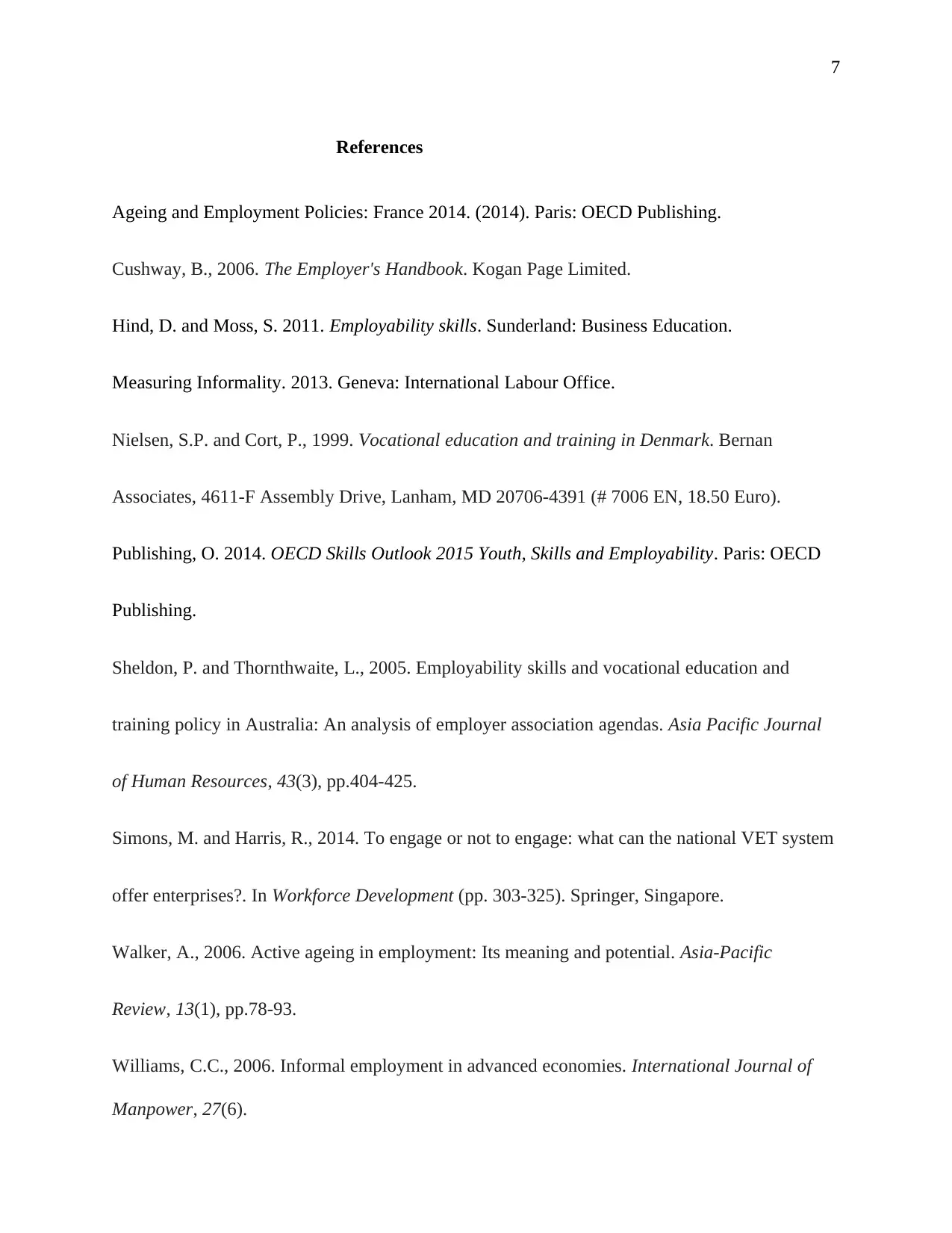
7
References
Ageing and Employment Policies: France 2014. (2014). Paris: OECD Publishing.
Cushway, B., 2006. The Employer's Handbook. Kogan Page Limited.
Hind, D. and Moss, S. 2011. Employability skills. Sunderland: Business Education.
Measuring Informality. 2013. Geneva: International Labour Office.
Nielsen, S.P. and Cort, P., 1999. Vocational education and training in Denmark. Bernan
Associates, 4611-F Assembly Drive, Lanham, MD 20706-4391 (# 7006 EN, 18.50 Euro).
Publishing, O. 2014. OECD Skills Outlook 2015 Youth, Skills and Employability. Paris: OECD
Publishing.
Sheldon, P. and Thornthwaite, L., 2005. Employability skills and vocational education and
training policy in Australia: An analysis of employer association agendas. Asia Pacific Journal
of Human Resources, 43(3), pp.404-425.
Simons, M. and Harris, R., 2014. To engage or not to engage: what can the national VET system
offer enterprises?. In Workforce Development (pp. 303-325). Springer, Singapore.
Walker, A., 2006. Active ageing in employment: Its meaning and potential. Asia-Pacific
Review, 13(1), pp.78-93.
Williams, C.C., 2006. Informal employment in advanced economies. International Journal of
Manpower, 27(6).
References
Ageing and Employment Policies: France 2014. (2014). Paris: OECD Publishing.
Cushway, B., 2006. The Employer's Handbook. Kogan Page Limited.
Hind, D. and Moss, S. 2011. Employability skills. Sunderland: Business Education.
Measuring Informality. 2013. Geneva: International Labour Office.
Nielsen, S.P. and Cort, P., 1999. Vocational education and training in Denmark. Bernan
Associates, 4611-F Assembly Drive, Lanham, MD 20706-4391 (# 7006 EN, 18.50 Euro).
Publishing, O. 2014. OECD Skills Outlook 2015 Youth, Skills and Employability. Paris: OECD
Publishing.
Sheldon, P. and Thornthwaite, L., 2005. Employability skills and vocational education and
training policy in Australia: An analysis of employer association agendas. Asia Pacific Journal
of Human Resources, 43(3), pp.404-425.
Simons, M. and Harris, R., 2014. To engage or not to engage: what can the national VET system
offer enterprises?. In Workforce Development (pp. 303-325). Springer, Singapore.
Walker, A., 2006. Active ageing in employment: Its meaning and potential. Asia-Pacific
Review, 13(1), pp.78-93.
Williams, C.C., 2006. Informal employment in advanced economies. International Journal of
Manpower, 27(6).
1 out of 7
Related Documents
Your All-in-One AI-Powered Toolkit for Academic Success.
+13062052269
info@desklib.com
Available 24*7 on WhatsApp / Email
![[object Object]](/_next/static/media/star-bottom.7253800d.svg)
Unlock your academic potential
Copyright © 2020–2025 A2Z Services. All Rights Reserved. Developed and managed by ZUCOL.



